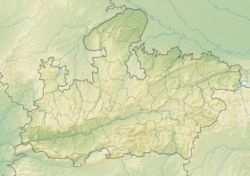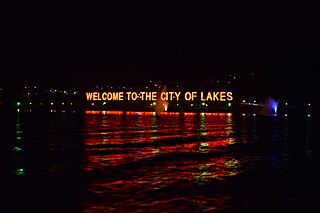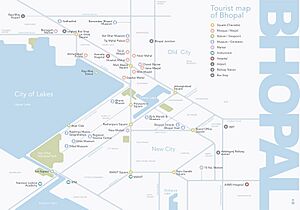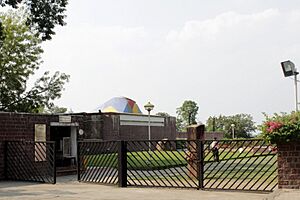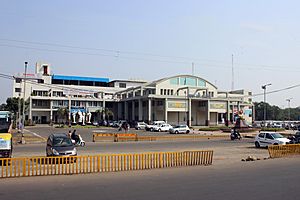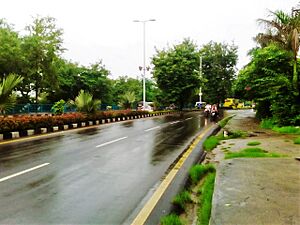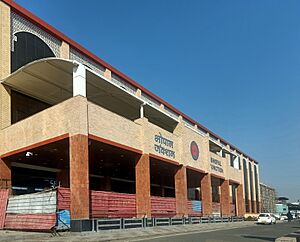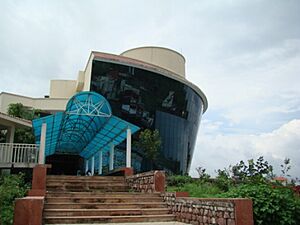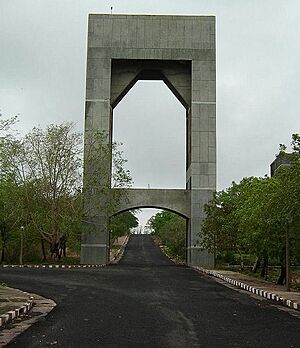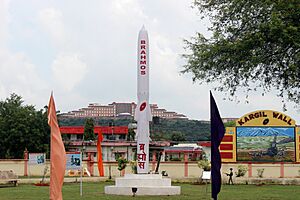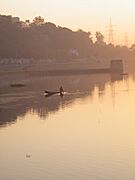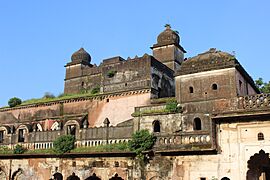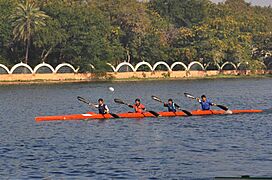Bhopal facts for kids
Quick facts for kids
Bhopal
Bhōpāla
|
|
|---|---|
|
(from top to bottom) Bhojtaal, Sanchi Stupa, Taj-ul-Masajid, Tribal Museum Bhopal, Van Vihar National Park, Museum of Man
|
|
| Nickname(s):
The City of Lakes
|
|
| Country | |
| State | |
| District | Bhopal |
| Region | Bhopal Division |
| Ward | 85 wards |
| Named for | Raja Bhoja |
| Government | |
| • Type | Mayor–Council |
| • Body | Bhopal Municipal Corporation |
| Area | |
| • Metropolis | 463 km2 (179 sq mi) |
| • Metro | 648.24 km2 (250.29 sq mi) |
| Elevation | 518.73 m (1,701.87 ft) |
| Population
(2011)
|
|
| • Metropolis | 1,798,218 |
| • Rank | 20th |
| • Density | 3,884/km2 (10,059/sq mi) |
| • Metro
(Bhopal + Arera Colony + Berasia urban areas) |
1,917,051 |
| • Metro density | 2,957.317/km2 (7,659.42/sq mi) |
| • Metro rank | 18th |
| Demonym(s) | Bhopali |
| Time zone | UTC+5:30 (IST) |
| Pincode |
462001 to 462050
|
| Telephone | 0755 |
| Vehicle registration | MP-04 |
| Per capita GDP | $2,087 or ₹1.47 lakh |
| GDP Nominal (Bhopal District) | ₹44,175 crore (US$7.5 billion) (2020–21) |
| Official language | Hindi |
| Literacy Rate (2011) | 80.37% |
| Precipitation | 1,123.1 millimetres (44.22 in) |
| Avg. high temperature | 31.7 °C (89.1 °F) |
| Avg. low temperature | 18.6 °C (65.5 °F) |
| HDI (2016) | 0.77 (High) |
Bhopal is the capital city of the Indian state of Madhya Pradesh. It is also the main city for the Bhopal district and Bhopal division. People often call it the City of Lakes because it has many natural and man-made lakes. Bhopal is also known as one of the greenest cities in India. It is the 16th largest city in India.
Bhopal has a strong economy with many big and medium-sized industries. It is one of the most important financial places in Madhya Pradesh, along with Indore. Bhopal is home to many important educational and research centers. These include ISRO's Master Control Facility and BHEL.
In December 1984, Bhopal faced a major industrial accident. A pesticide plant leaked dangerous gases, which caused a lot of harm. This event is still talked about today.
Bhopal was chosen to be one of the first "smart cities" in India. It has also been named the cleanest state capital city in India for several years. In 2023, it received a 5-star rating for being a Garbage Free City.
Contents
- What's in a Name? The Meaning of Bhopal
- A Look Back: The History of Bhopal
- Bhopal's Location and Environment
- People of Bhopal: Demographics and Culture
- Bhopal's Economy: Industries and Growth
- Getting Around: Transport in Bhopal
- Learning in Bhopal: Education and Research
- Sports in Bhopal
- Exploring Bhopal: Places to Visit
- Famous People from Bhopal
- Military Presence in Bhopal
- See also
What's in a Name? The Meaning of Bhopal
Bhopal gets its name from the ancient king Raja Bhoja. The first part, 'Bho', might come from his name. The second part, 'Pal', means 'dam' or 'reservoir'. This makes sense because the city has many lakes. So, Bhopal could mean 'City of Raja Bhoja' or 'City of Lakes'.
A Look Back: The History of Bhopal
How Bhopal Began

Stories say that Bhopal was founded in the 11th century by King Bhoja. He ruled from his capital at Dhar. Some believe it was first called Bhojpal after a dam built by his minister. Another idea is that it's named after a different king, Bhupala. One story says King Bhoj built a lake from 365 rivers to cure his illness. This lake was called Bhoj Tal, and the city became Bhojpal, then Bhopal.
The modern city of Bhopal was started by Dost Mohammad Khan in the early 1700s. He was a soldier in the Mughal Empire army. After the emperor died, he began working for local leaders. In 1709, he took over the Berasia area and later created the Bhopal State. He built the Fatehgarh fort, which helped the city grow.
Bhopal Under Different Rulers
From 1737 to 1818, Bhopal and nearby areas were controlled by the Maratha Confederacy. This happened after the Maratha army defeated the Mughal and Nawab forces in the Battle of Bhopal (1737).
Bhopal became a princely state under British rule in 1818. From 1819 to 1926, four women rulers, called Begums, governed the state. This was very unusual for that time! Qudsia Begum was the first. Later, Sikandar supported the British during the Indian Rebellion of 1857. For this, she was given great honors, including a special title.
The Begums helped the city grow. They built water systems, railways, a postal service, and set up a city government in 1907. The last Begum, Kaikhusrau Jahan, stepped down in 1926. Her son, Hamidullah Khan, ruled until India became independent in 1947.
Bhopal After India's Independence
After India gained independence in 1947, the last Nawab of Bhopal wanted to keep it as a separate state. But people protested, and in 1949, Bhopal joined the country of India.
The Bhopal Industrial Accident of 1984
In December 1984, a factory in Bhopal had a terrible gas leak. This event is known as the Bhopal disaster. It was one of the worst industrial accidents ever. The leak released toxic gases, mainly methyl isocyanate.
Thousands of people died, and many more suffered long-term health problems. The effects of the disaster, like health issues and environmental pollution, are still a challenge for the people of Bhopal today. Efforts are ongoing to clean up the factory site and help those affected.
Bhopal's Location and Environment
Where is Bhopal?
Bhopal is in the central part of India, on the Malwa plateau. It sits higher than the northern plains. The city has hills like Idgah, Arera, and Shyamala.
Bhopal is famous for its lakes. The two biggest are Upper Lake (also called Bada Talab) and Lower Lake. The Upper Lake was built in the 11th century. The city is split into two main parts: Old Bhopal (north), near the lakes, and New Bhopal (south), where many modern malls are.
Bhopal's Weather
| Weather chart for Bhopal | |||||||||||||||||||||||||||||||||||||||||||||||
|---|---|---|---|---|---|---|---|---|---|---|---|---|---|---|---|---|---|---|---|---|---|---|---|---|---|---|---|---|---|---|---|---|---|---|---|---|---|---|---|---|---|---|---|---|---|---|---|
| J | F | M | A | M | J | J | A | S | O | N | D | ||||||||||||||||||||||||||||||||||||
|
13
24
9
|
7.8
28
11
|
7.2
34
17
|
4.5
38
22
|
8
41
26
|
114
37
25
|
356
31
23
|
388
29
22
|
196
31
21
|
26
32
18
|
14
29
12
|
12
25
10
|
||||||||||||||||||||||||||||||||||||
| temperatures in °C precipitation totals in mm |
|||||||||||||||||||||||||||||||||||||||||||||||
|
Imperial conversion
|
|||||||||||||||||||||||||||||||||||||||||||||||
Bhopal has a humid subtropical climate. This means it has cool, dry winters, hot summers, and a humid monsoon season. Summers are from late March to mid-June, with temperatures often above 40 °C (104 °F). The monsoon season is from late June to late September, bringing lots of rain and thunderstorms. Winters are cool, from early November to early March.
Bhopal was ranked the 6th best "National Clean Air City" in India in 2024.
| Climate data for Bhopal (Bairaghar) 1991–2020, extremes 1949–present | |||||||||||||
|---|---|---|---|---|---|---|---|---|---|---|---|---|---|
| Month | Jan | Feb | Mar | Apr | May | Jun | Jul | Aug | Sep | Oct | Nov | Dec | Year |
| Record high °C (°F) | 33.0 (91.4) |
37.6 (99.7) |
40.7 (105.3) |
44.4 (111.9) |
46.7 (116.1) |
45.6 (114.1) |
41.2 (106.2) |
35.6 (96.1) |
37.4 (99.3) |
39.6 (103.3) |
35.3 (95.5) |
32.8 (91.0) |
46.0 (114.8) |
| Mean daily maximum °C (°F) | 24.9 (76.8) |
28.4 (83.1) |
33.9 (93.0) |
38.7 (101.7) |
41.1 (106.0) |
37.4 (99.3) |
30.9 (87.6) |
28.9 (84.0) |
31.3 (88.3) |
32.7 (90.9) |
29.9 (85.8) |
26.7 (80.1) |
32.1 (89.7) |
| Daily mean °C (°F) | 17.6 (63.7) |
21.0 (69.8) |
26.0 (78.8) |
30.8 (87.4) |
34.0 (93.2) |
31.0 (87.8) |
26.9 (80.4) |
25.7 (78.3) |
26.6 (79.9) |
25.8 (78.4) |
22.3 (72.1) |
18.7 (65.7) |
25.5 (78.0) |
| Mean daily minimum °C (°F) | 10.6 (51.1) |
13.1 (55.6) |
17.6 (63.7) |
22.4 (72.3) |
26.6 (79.9) |
26.0 (78.8) |
23.8 (74.8) |
23.0 (73.4) |
22.2 (72.0) |
19.1 (66.4) |
15.0 (59.0) |
11.2 (52.2) |
19.2 (66.6) |
| Record low °C (°F) | 0.6 (33.1) |
1.7 (35.1) |
6.1 (43.0) |
12.2 (54.0) |
16.7 (62.1) |
19.5 (67.1) |
19.0 (66.2) |
16.8 (62.2) |
13.8 (56.8) |
11.7 (53.1) |
6.1 (43.0) |
1.0 (33.8) |
0.6 (33.1) |
| Average rainfall mm (inches) | 11.3 (0.44) |
9.4 (0.37) |
8.8 (0.35) |
6.5 (0.26) |
14.2 (0.56) |
132.8 (5.23) |
367.7 (14.48) |
326.0 (12.83) |
175.6 (6.91) |
31.5 (1.24) |
8.7 (0.34) |
8.5 (0.33) |
1,101 (43.35) |
| Average rainy days | 0.9 | 0.9 | 0.8 | 0.6 | 1.2 | 7.3 | 14.4 | 13.9 | 8.1 | 1.8 | 0.6 | 0.2 | 50.7 |
| Average relative humidity (%) (at 17:30 IST) | 42 | 33 | 24 | 19 | 22 | 46 | 74 | 79 | 66 | 45 | 43 | 43 | 45 |
| Mean monthly sunshine hours | 279.0 | 271.2 | 285.2 | 303.0 | 303.8 | 195.0 | 108.5 | 105.4 | 192.0 | 275.9 | 270.0 | 263.5 | 2,852.5 |
| Mean daily sunshine hours | 9.0 | 9.6 | 9.2 | 10.1 | 9.8 | 6.5 | 3.5 | 3.4 | 6.4 | 8.9 | 9.0 | 8.5 | 7.8 |
| Source 1: India Meteorological Department (sun 1971–2000) | |||||||||||||
| Source 2: Tokyo Climate Center (mean temperatures 1991–2020) | |||||||||||||
Bhopal's Lakes and Reservoirs
Bhopal is famous for its many lakes. Here are some of them:
- Bhojtal (Upper Lake)
- Chhota Talaab (Lower Lake)
- Shahpura Lake
- Motia Talaab
- Sarangpani Lake
- Manit Lotus Lake
- Jawahar Baal Udhyaan Lake
- Lendiya Talaab
- Preet Nagar Lake
- Nariyalkheda Golf Course Lake
- Laharpur Lake
- Mullah Sarovar
- Nevri Talaab
- New Jail Pond
- Bairagarh Visarjan Ghat
The city also has several important reservoirs that supply water:
- Kolar Dam
- Kerwa Dam
- Kaliyasot Dam
- Halali Dam
- Bhadbhada Dam
- Hathaikheda Dam
People of Bhopal: Demographics and Culture
Bhopal's Population
| Religion in Bhopal City (2011) | ||||
|---|---|---|---|---|
| Religion | Percent | |||
| Hinduism | 69.20% | |||
| Islam | 26.28% | |||
| Jainism | 1.35% | |||
| Christianity | 1.12% | |||
| Buddhism | 1.08% | |||
| Others† | 0.6% | |||
| Population % by religion; †Includes Sikhs | ||||
In 2011, Bhopal city had about 1.8 million people. The larger Bhopal metropolitan area had over 1.9 million people. Most people in Bhopal can read and write, with a literacy rate of over 85%.
Festivals and Traditions
Diwali is a big festival in Bhopal. People exchange gifts and sweets. They also give donations to those in need. During Ganesh puja and Durga Puja, statues of gods are set up around the city. People visit to pray. At the end of Navratras, on Vijayadashami, large figures of Ravana are burned.
Eid is another important festival. The Bhopal Ijtema is a huge annual gathering of Muslim preachers. It attracts hundreds of thousands of Muslims from all over the world.
Bhopal's Architecture
The former rulers of Bhopal, the Nawabs of Bhopal, built many beautiful buildings. These include the Taj-ul-Masajid and the Taj Mahal palace. Their designs mix Indian and European styles.
Bharat Bhavan is a major cultural center in Bhopal. It hosts many theater and film festivals. It has an art gallery, an outdoor theater, and a tribal museum.
Bhopal's Economy: Industries and Growth
Bhopal's economy is mainly based on industries. These include making medicines, cars, clothes, jewelry, and electronics. Other businesses include cotton and flour mills. People in Bhopal also run large shops. Handicrafts like zardozi (fancy embroidery) and batua (small purses) are popular in the Old City.
Bhopal is home to DB Corp, a big media company known for its newspaper Dainik Bhaskar. An IT Park near the airport has many software companies. Big companies like WIPRO are planning to open offices here.
Major Industries in Bhopal
- BHEL: This is a very large engineering and manufacturing company in India. It has a big factory in Bhopal.
- Mandideep: This is an industrial area near Bhopal. It has factories that make things like tractors and electrical parts.
- New industrial zones: Areas like Bagroda AKVN and Acharpura are growing fast. The government is helping companies set up factories there. Many big companies have already invested in these areas.
Future Projects in Bhopal
Bhopal has many exciting projects planned for the future.
- Industrial Growth: The government is developing more industrial areas like Bagroda Industrial Area Phase-2 and Berasia Industrial Area. These will bring more factories and jobs.
- Skill Development: A huge skill park, called the Global Skills Park, is being built. It will help people learn new skills for jobs. It is expected to open by the end of 2023.
- IT Development: The IT Park near Bhopal Airport is hoping to attract more software companies.
- Infrastructure: Bhopal will be an important city in the new Delhi-Nagpur industrial corridor. A large logistics park is planned near Mandideep. Also, a new ring road project is underway to improve traffic flow.
Getting Around: Transport in Bhopal
Travel by Air
The Raja Bhoj International Airport is the main airport for Madhya Pradesh. It is about 15 km north of the city. You can reach it by three different routes. Airlines like Air India, Spice Jet, and Indigo offer flights to major Indian cities.
Travel by Road
National Highway 46 goes around Bhopal, connecting it to cities like Jabalpur and Jaipur. Other highways link Bhopal to Sagar, Kanpur, and Indore.
Bhopal has a large bus station called the Kushabhau Thakre Inter State Bus Terminal. It was opened in 2011 and is near the Habibganj railway station.
Travel by Rail
Trains started running in Bhopal in 1884. The Bhopal Junction railway station is a major station. Many trains stop or start here every day. Another important station is Habibganj railway station (now called Rani Kamalapati railway station). It is known as India's first private and world-class railway station.
City Transport
Bhopal's Bus System
The Bus Rapid Transit System (BRTS) started in 2013. It uses special bus lanes to help buses move faster. The system has many routes and bus stops across the city. However, the government decided to stop the BRTS project in December 2023 due to traffic issues.
Bhopal Metro Rail
The Bhoj Metro project is currently being built in Bhopal. This new metro system will help people travel around the city more easily.
Learning in Bhopal: Education and Research
Schools in Bhopal
Bhopal has over 550 government-funded schools. Most of these schools follow the Madhya Pradesh Board of Secondary Education (MPBSE). There are also many private schools that follow different education boards like CBSE and ICSE. Some well-known schools include Delhi Public School, Bhopal, The Sanskaar Valley School, and Campion School Bhopal.
Colleges and Universities
Bhopal is home to many important colleges and universities. These include:
- National Law Institute University (1997)
- Maulana Azad National Institute of Technology (1960)
- Indian Institute of Forest Management (1982)
- Barkatullah University (1970)
- Indian Institute of Science Education and Research, Bhopal (2008)
- All India Institute of Medical Science (2012)
- Jagran Lakecity University (2013)
- Indian Institute of Information Technology (2017)
Research Centers
Bhopal also has several research institutes. These include the CSIR AMPRI and the IISER. They conduct important scientific research.
Sports in Bhopal
Sports Teams
The Bhopal Badshahs is a hockey team from Bhopal. They play in the World Series Hockey league. Their home ground is the Aishbagh Stadium.
Sports Stadiums
- Aishbagh Stadium: This stadium is used for field hockey games.
- TT Nagar Stadium: This is a multi-purpose stadium in Bhopal, used for various sports.
Exploring Bhopal: Places to Visit
World Heritage Sites Near Bhopal

- Bhimbetka Caves: About 35 km from Bhopal, these caves have ancient rock paintings from over 12,000 years ago! They show how early humans lived. There are about 600 caves, and 12 are open to visitors. UNESCO made them a World Heritage Site in 2003.
- Sanchi Stupas: Located about 47 km from Bhopal, the Great Stupa at Sanchi is a famous Buddhist monument. It was first built by Emperor Ashoka over 2,000 years ago. There are other stupas and ancient buildings on the hill.
Nature and Wildlife
- Van Vihar National Park: This national park in Bhopal is managed like a modern zoo. Animals here are often rescued or exchanged from other zoos. You can drive through the park and see animals in a natural setting.
- Bhoj Wetland: This area is great for bird watching. Many migratory birds from Central Asia come here in winter. You can see rare birds like the Sarus crane.
- Ratapani Tiger Reserve: Located near Bhopal, this reserve is home to over 50 tigers. It's special because wild tigers live very close to the city!
- Halali Dam: About 38 km north of Bhopal, this large water body attracts many birds, especially in winter.
Popular Tourist Spots
- Upper Lake (Bhopal) and Lower Lake (Bhopal)
- Van Vihar National Park and Bhoj Wetland Ramsar Site
- Museum of Man
- Tribal Museum and State Archaeological Museum
- Bharat Bhavan
- Taj-ul-Masjid
- Taj Mahal Palace
- Kamlapati Palace and Kamla Park
- Regional Museum of Natural History
- Shaurya Smarak
Nearby Attractions
- Sanchi – A UNESCO World Heritage site with ancient stupas.
- Bhojpur – Known for its large unfinished Shiva temple.
- Bhimbetka rock shelters – Famous for prehistoric rock paintings.
- Raisen – Home to a historic fort.
Fun Activities and Shopping
The Museum of Man shows different types of tribal and folk houses from all over India.
For shopping, the New Market is a busy area with many shops and businesses. You can also find big malls like DB City Mall. In the Old City, Chowk Bazar and Sarafa are great for traditional shopping.
Famous People from Bhopal
Writers and Poets
- Muskan Ahirwar - librarian
- Javed Akhtar – famous poet and writer
- Bashir Badr – poet
- Asad Bhopali – poet and lyricist
- Kaif Bhopali – poet and lyricist
- Manzar Bhopali – poet
Sports Stars
- Jai Prakash Yadav - Cricket Player
- Fatima Bano - female wrestling coach
- Sameer Dad – National hockey player
- Bhawna Dehariya – First woman from Madhya Pradesh to climb Mount Everest
- Aslam Sher Khan – National hockey player and Member of Parliament
- Mansoor Ali Khan Pataudi – Former Captain of the India national cricket team
Film, TV, and Art Personalities
- Jaya Bachchan – famous actress
- Stebin Ben – Singer
- Annu Kapoor – Actor and TV presenter
- Sara Khan – Actress
- Divyanka Tripathi – Actress
Military Presence in Bhopal
Bhopal is an important city for the Indian Armed Forces. It has various military units stationed there. The Bhopal Cantt is known as a peace station. The city also hosts units of the National Cadet Corps (NCC) for the Army, Air Force, and Navy wings.
See also
 In Spanish: Bhopal para niños
In Spanish: Bhopal para niños








